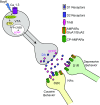From Gene to Behavior: L-Type Calcium Channel Mechanisms Underlying Neuropsychiatric Symptoms
- PMID: 28497380
- PMCID: PMC5509628
- DOI: 10.1007/s13311-017-0532-0
From Gene to Behavior: L-Type Calcium Channel Mechanisms Underlying Neuropsychiatric Symptoms
Abstract
The L-type calcium channels (LTCCs) Cav1.2 and Cav1.3, encoded by the CACNA1C and CACNA1D genes, respectively, are important regulators of calcium influx into cells and are critical for normal brain development and plasticity. In humans, CACNA1C has emerged as one of the most widely reproduced and prominent candidate risk genes for a range of neuropsychiatric disorders, including bipolar disorder (BD), schizophrenia (SCZ), major depressive disorder, autism spectrum disorder, and attention deficit hyperactivity disorder. Separately, CACNA1D has been found to be associated with BD and autism spectrum disorder, as well as cocaine dependence, a comorbid feature associated with psychiatric disorders. Despite growing evidence of a significant link between CACNA1C and CACNA1D and psychiatric disorders, our understanding of the biological mechanisms by which these LTCCs mediate neuropsychiatric-associated endophenotypes, many of which are shared across the different disorders, remains rudimentary. Clinical studies with LTCC blockers testing their efficacy to alleviate symptoms associated with BD, SCZ, and drug dependence have provided mixed results, underscoring the importance of further exploring the neurobiological consequences of dysregulated Cav1.2 and Cav1.3. Here, we provide a review of clinical studies that have evaluated LTCC blockers for BD, SCZ, and drug dependence-associated symptoms, as well as rodent studies that have identified Cav1.2- and Cav1.3-specific molecular and cellular cascades that underlie mood (anxiety, depression), social behavior, cognition, and addiction.
Keywords: Addiction; CACNA1C; CACNA1D; Cav1.2; Cav1.3; Mood; Social.
Figures



References
Publication types
MeSH terms
Substances
Grants and funding
LinkOut - more resources
Full Text Sources
Other Literature Sources
Medical

